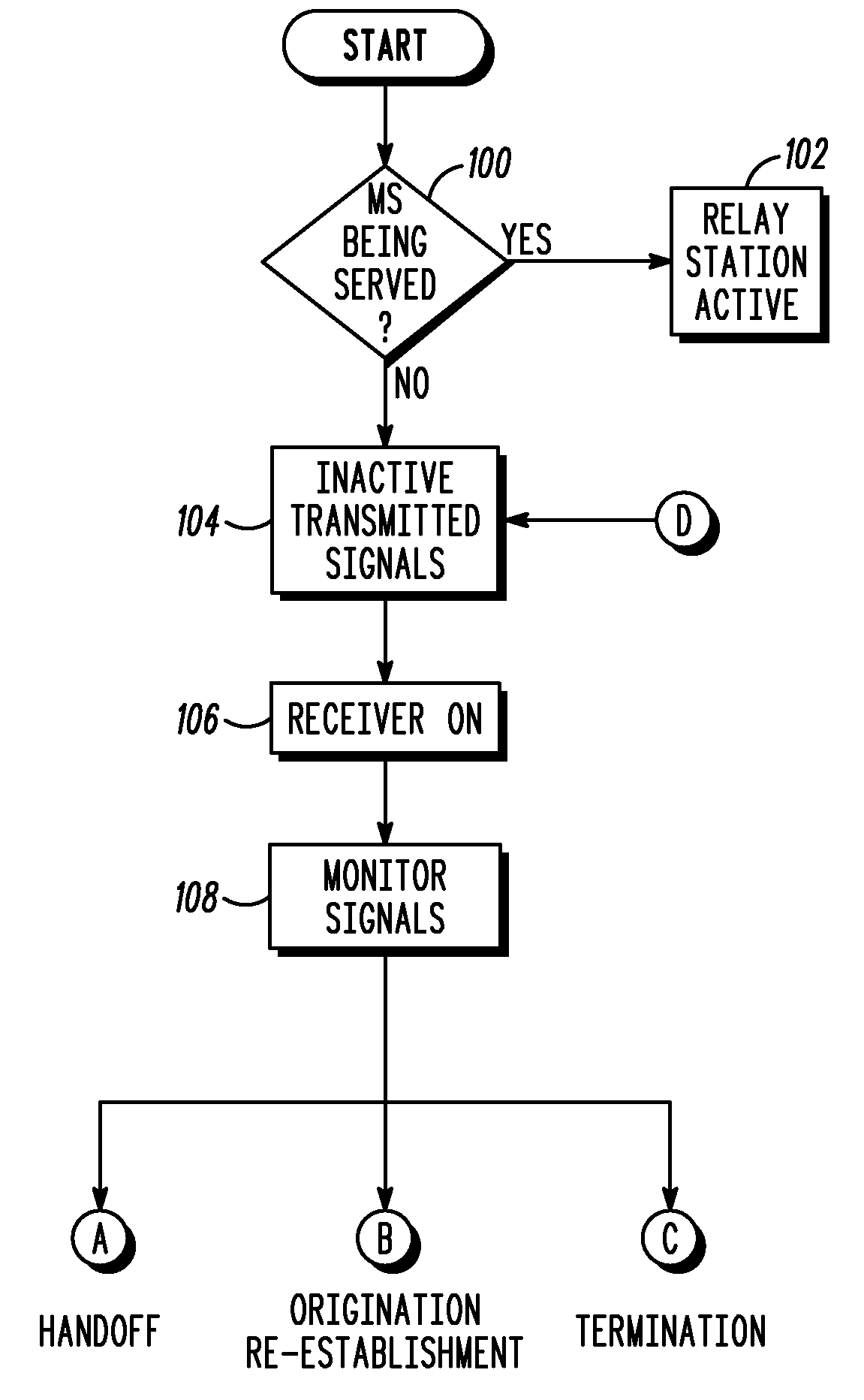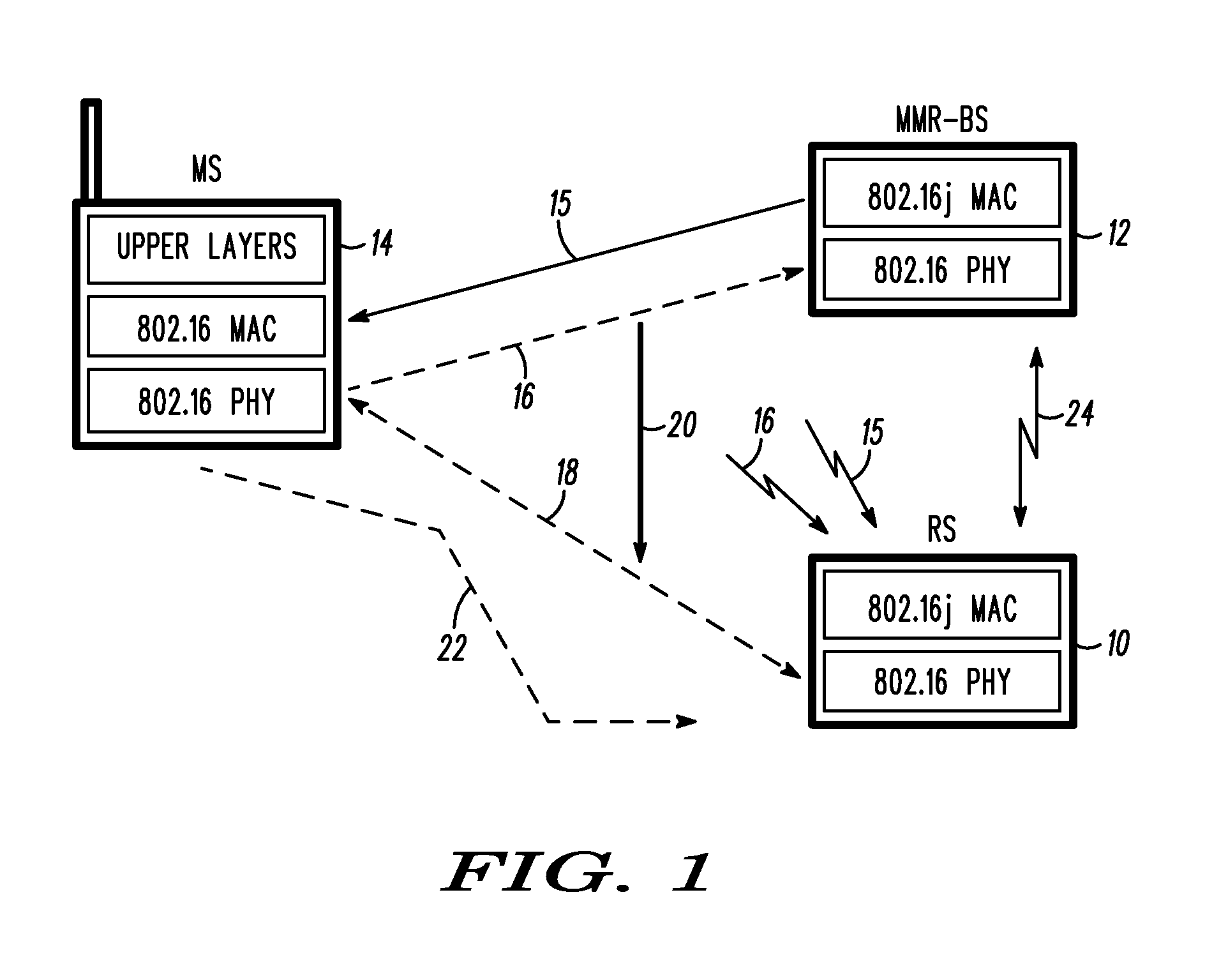Wireless wide-area communication network multihop relay station management
a multi-hop relay station and wireless communication technology, applied in power management, wireless commuication services, high-level techniques, etc., can solve problems such as difficulty in channel quality estimation of both uplink (ul) and downlink (dl) channels between ms and rs, and lack of optimal mechanism for managing the operation of relay stations
- Summary
- Abstract
- Description
- Claims
- Application Information
AI Technical Summary
Problems solved by technology
Method used
Image
Examples
first embodiment
[0034]Referring to FIGS. 2 and 3, a first embodiment for activating the RS involves a handoff of an active MS. In this embodiment, the inactive RS estimates 110 a channel quality of at least one mobile station from the monitored signals. A next step includes activating 112 the relay station in response to the monitored signals indicating that a channel quality of the mobile station will improve when being served by the relay station. The estimating step 110 can include identifying a modulation and coding scheme (MCS) from the monitored signals and estimating an associated channel quality therefor. If a MS is using a low coding rate this is typically due to poor channel conditions. Therefore, knowing a MCS can directly relate to channel quality. The estimating step 110 can also include estimating path losses of the monitored signals between the mobile station and base station and between the mobile station and relay station. The actual determination of path losses has been described ...
second embodiment
[0036]Referring to FIGS. 2 and 4, a second embodiment for activating the RS involves a call origination or re-establishment of a MS. In this embodiment, the inactive RS monitor 108 a power level of at least one of a ranging request and a bandwidth request made by a mobile station trying to originate or re-establish a call. In this embodiment, the RS will list 120 a mobile station as a potential candidate for service from the relay station if the request is above a predetermine power threshold. The RS will subsequently monitor 122 power levels of a ranging and bandwidth requests to detect whether the mobile station is repeating requests for the same service. If repeated requests are detected 124 (i.e. a BS is not responding), the RS can then activate itself 126 to serve the mobile station, which includes performing the necessary communication with the serving BS to complete the call origination or re-establishment of the MS. Otherwise, the RS remains inactive.
[0037]As in the first em...
third embodiment
[0038]Referring to FIGS. 2 and 5, a third embodiment for activating the RS involves call termination. In this embodiment, the inactive RS monitors 108 paging requests for termination made by a mobile station. If repeated paging requests are detected 128 (i.e. a BS is not responding), the relay station can activate itself 130 to serve the mobile station, which includes performing the necessary communication with the serving BS to complete the call termination of the MS. Otherwise, the RS remains inactive.
[0039]If only one MS was being served and has terminated its call, the RS can immediately proceed to deactivate itself. Alternatively, as in the first embodiment, once the RS is active, a next step can include determining 114 whether the activated relay station results in more than a predetermined amount of interference. Determining the interference from signals is well known in the art, and any of those known techniques can be used in this instance. If it is determined 116 that the ...
PUM
 Login to View More
Login to View More Abstract
Description
Claims
Application Information
 Login to View More
Login to View More - R&D
- Intellectual Property
- Life Sciences
- Materials
- Tech Scout
- Unparalleled Data Quality
- Higher Quality Content
- 60% Fewer Hallucinations
Browse by: Latest US Patents, China's latest patents, Technical Efficacy Thesaurus, Application Domain, Technology Topic, Popular Technical Reports.
© 2025 PatSnap. All rights reserved.Legal|Privacy policy|Modern Slavery Act Transparency Statement|Sitemap|About US| Contact US: help@patsnap.com



